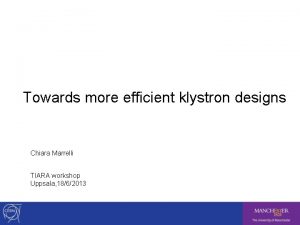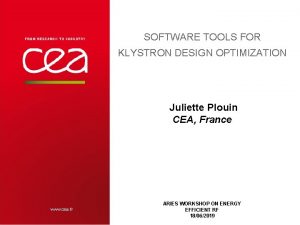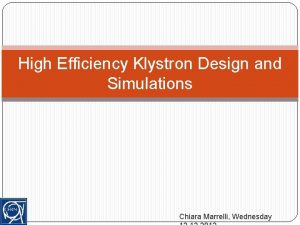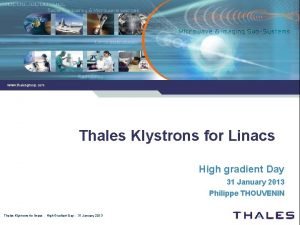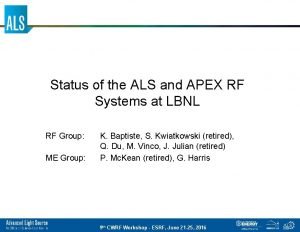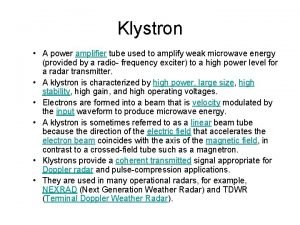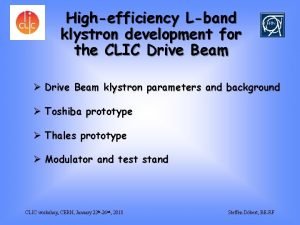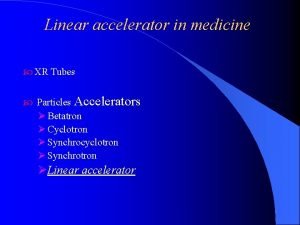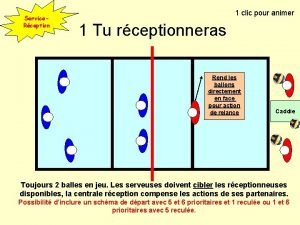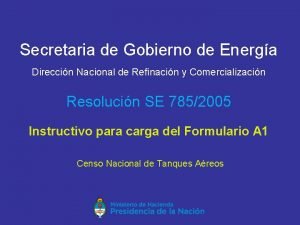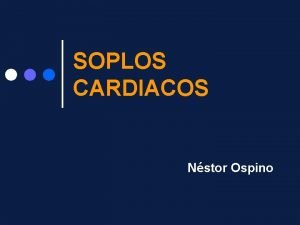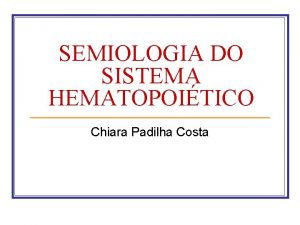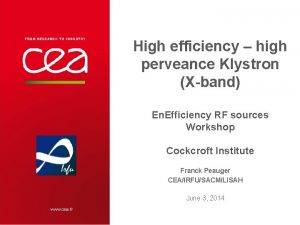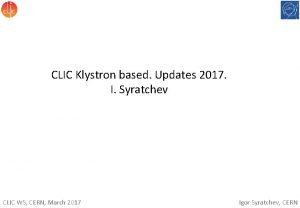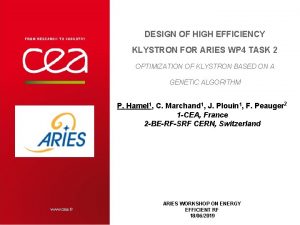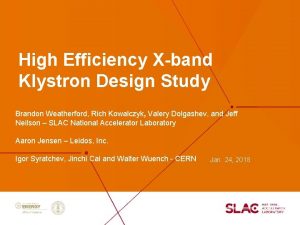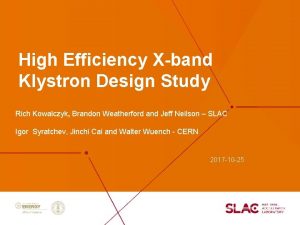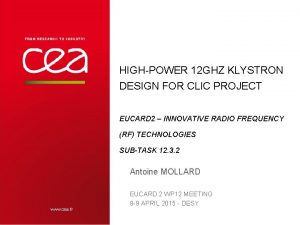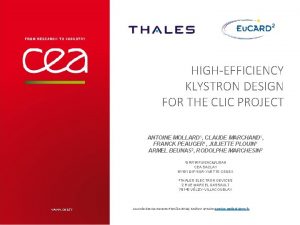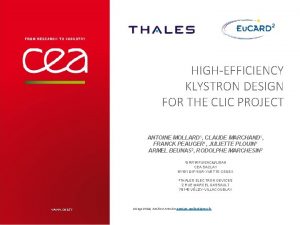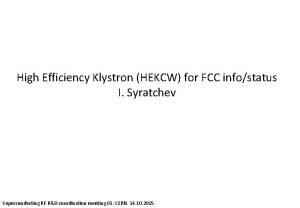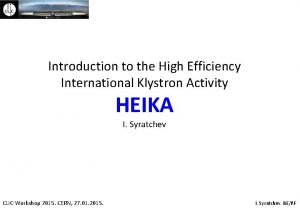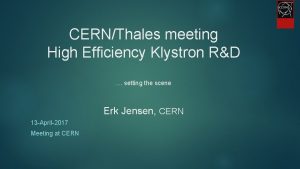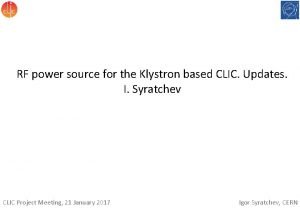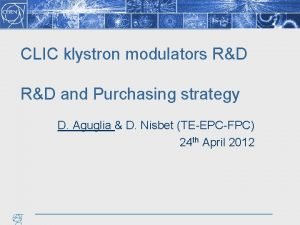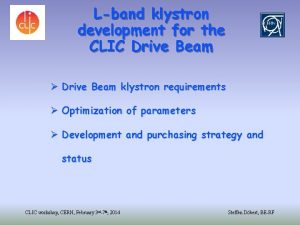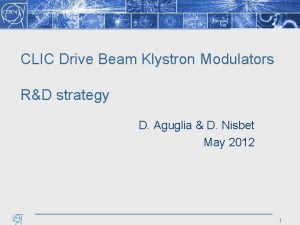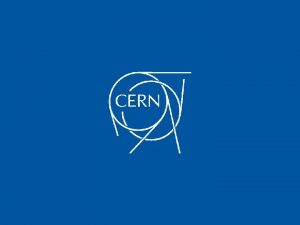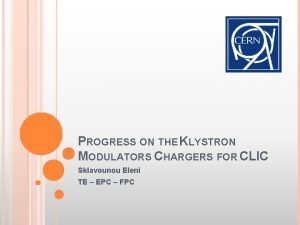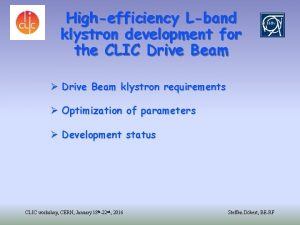HIGH EFFICIENCY KLYSTRON DESIGN Chiara Marrelli RF CLIC







![Klystron design: AJDisk Simulation routine[2] (2) : 4. 5. 6. AJDisk evaluates for each Klystron design: AJDisk Simulation routine[2] (2) : 4. 5. 6. AJDisk evaluates for each](https://slidetodoc.com/presentation_image_h2/8729362bb40a6b075cacee914cb46c27/image-8.jpg)

























- Slides: 33

HIGH EFFICIENCY KLYSTRON DESIGN Chiara Marrelli RF CLIC meeting 25/06/2014

Outline • Why high efficiency? • Introduction • 1 D klystron code AJDisk • Classical approach to klystron design • Efficiency-perveance study • New methods to improve klystron efficiency and examples • More on harmonic cavities in klystrons and PIC simulations • References

High efficiency power sources for future accelerators CLIC drive beam complex @ 3 Te. V [1]: 1638 accelerating structures with 1 GHz RF pulses of 15 MW: total pulsed RF power of 24. 57 GW required Pulse length of 150 ms and repetition rate of 50 Hz average RF power at the accelerating structure input is 184 MW with challenging specifications in terms of stability: • ± 0. 05° in phase • 0. 2% in amplitude High efficiency sources needed to provide this power at affordable cost (efficiency>70%), not only for CLIC, but for all future accelerators (ILC, ESS linac, FCC) In most cases klystrons have been identified so far as the most viable power source: since the efficiency of klystron modulators that can presently reach values over 90%, the power source itself is really the weak point for the improvement of the machine overall efficiency.

How a klystron works • • • Continuous beam emitted from thermionic cathode Input bunching cavity (RF input from the preamplifier) The beam is velocity modulated Velocity modulation becomes density modulation in the drift Due to bunching the beam current gets a strong RF component The RF component of the beam current excites a field in the output cavity. The field is extracted by the output waveguide and the beam looses its energy and reaches the collector (like waves on the shore, as the greek word κλυσ suggests). • Idler cavities can enhance bunching

Klystron efficiency microperveance Perveance indicates how much beam current comes out of the cathode when the voltage V is applied between the cathode and the anode. Perveance can be considered as well as a measure of space charge forces. A low perveance beam has weaker space-charge forces and it enables stronger bunching and thus consequently higher efficiency. Low perveance low microperveance for high efficiency low output power Many single beam interact in common cavities. Perveance is referred to the single beam, while the output power is the combined one. Commercial 10 MW L-band MBK (Courtesy of I. Syratchev) multibeam klystrons

Klystron efficiency Main factors affecting klystron (electronic) efficiency: Power Extraction from bunched beam Bunching • High peak RF current at output • Tight bunches • Low space charge (low microperveance) • Kinetic energy of the electrons fully transferred to the field • Particles have to be uniformly decelerated at minimum possible speed without reflected electrons • The internal bunch structure has to be considered

Klystron design: AJDisk Procedure: • Simulations and optimization with 1 D code (ex: AJDisk from SLAC) • Cavity design (SUPERFISH, HFSS) • 2/3 -D simulations (PIC) AJDisk [2]: • 1 -D code currently used at SLAC for the design of round and sheet beam klystrons; • The beam is split into a series of disks of charge moving only in the longitudinal direction; • Disks are acted by both the cavity fields and the space charge fields; • Reliable for small beam currents; no transverse forces considered Simulation routine[2] (1) : 1. 2. 3. Initialization of data: beam loading admittance (Gb and Bb), gap quality factors and impedances (Qn and Zn), etc. The input voltage is calculated from the desired input power, all the other voltages are set to zero. The beam is moved through the tunnel. To do this the electron beam is sliced into a set of charged disks. The motion of each disk is governed by the space charge from other disks and/or the electric field associated with each cavity. The cavity fields are calculated as the gap voltage multiplied by a shape factor f(z) and by an oscillating term (cosine). The field shape is given by a Gaussian approximation: M is the COUPLING COEFFICIENT, and it can be obtained from electromagnetic simulations (SUPERFISH or HFSS).
![Klystron design AJDisk Simulation routine2 2 4 5 6 AJDisk evaluates for each Klystron design: AJDisk Simulation routine[2] (2) : 4. 5. 6. AJDisk evaluates for each](https://slidetodoc.com/presentation_image_h2/8729362bb40a6b075cacee914cb46c27/image-8.jpg)
Klystron design: AJDisk Simulation routine[2] (2) : 4. 5. 6. AJDisk evaluates for each disk the equations of motion based on the sum of the cavity field and the space charge, and it calculates the voltages and the fundamental component of the induced currents in all the cavities. The cavity fields are then recalculated and the equations of motion are integrated again, iteratively, until the self-consistent solution is found. The space charge field is calculated as: For the equations of motion, AJDisk uses a finite difference domain method (FDTD); at each time step a new position and velocity are calculated based on the position and velocity from the preceding time step using an updated equation.

Klystron design: AJDisk Example: 1 GHz klystron, 5 cavities Electronic efficiency Kinetic efficiency

Klystron design: classical approach All the klystron parameters are tuned in order to maximize the RF beam current in the last cavity. This is normally done by varying: • Cavity impedances (R/Qs), in the “feasible” range for the given frequency and M. • Drift lengths, taking into account field overlapping and klystron overall length • I/O coupling (external Qs for input and output cavity) • Coupling coefficients Ms, which depend from gap shape and length • Cavity detuning Also, beam radius and pipe radius are optimized. Optimum efficiency is reached at saturation (simulations have to be done for different input power levels). Comments: 1. When maximizing the output power, we have to take into account that, if the induced voltage in the output gap is higher than the beam DC voltage, electrons are accelerated back towards the cathode. 2. The cavity parameters (R/Qs, M and Qext ) have to be carefully optimized to avoid reflected electrons; also, when optimizing the parameters, we have to think about the possible cavity design to obtain the optimized values.

Cavity detuning Detuning of klystron cavities is a major element in klystron design: • It helps to increase the harmonic current • It can be used to introduce non-linear beam modulation and to obtain the desired bunch structure at klystron output Different types of detuning : • Inductive detuning (most common: increases bunching) • Low-frequency detuning (reduces bunching but “aligns” electron velocities see BAC method by Guzilov) • Harmonic cavities

Inductive detuning: Cavity detuning If the cavity resonant frequency is higher than the working frequency, the cavity impedance has a negative complex phase; in this case the gap voltage is such that it accelerates electrons in the bunch tail, and decelerates electrons in the bunch head, thus further compressing the bunch. At the same time, for large detuning the cavity impedance is much lower than the beam impedance, so the gap voltage doesn’t usually exceed the beam voltage [3]. Example: second cavity of a 1 GHz klystron F 0 =1000 MHz Fcav =1005 MHz β Accelerated particles (bunch tail) V (k. V) t Decelerated particles (bunch head) Velocity spread is increased, and bunching is enhanced Particles β, 2 cm after the cavity

Cavity detuning Low frequency detuning: If the cavity resonant frequency is lower than the working frequency, the gap voltage is such that it decelerates slow electrons in the bunch tail, and accelerates fast electrons in the bunch head, thus debunching the beam. At the same time, velocity spread is reduced. Example: second cavity of a 1 GHz klystron F 0 =1000 MHz Fcav =990 MHz β V (k. V) Decelerated particles (bunch Tail) Accelerated particles (bunch head) t Particles β, 2 cm after the cavity

Harmonic cavities Second harmonic cavity: effect on the internal bunch structure If the frequency of a cavity is resonating at the second harmonic of the working frequency (or usually at a slightly lower frequency), the harmonic current in the beam is strongly increased. The process introduces nonlinear beam modulation: the second harmonic cavity creates two smaller bunches per RF period; these two sub-bunches are then usually merged into a single bunch by the penultimate cavity [3]. (bunch head) β (bunch tail) V (k. V) t

Efficiency-perveance study In order to have a global view of the best possible performances that could be obtained from klystrons using different technologies, we started, one year ago, a parametric study of the high efficiency klystron in order to: • Identify the main design parameters having influence on klystron performances in terms of efficiency, device length, phase stability, output power • Analyze possible improvements • Choose the most appropriate configuration for the Compact Linear Collider (and for future linear accelerators) Parametric study of the high efficiency klystrons in collaboration with Lancaster University, using AJDISK. • Simulation of many different devices using 5 cavities and producing 2. 3 MW output power • Comparisons of design : - with and without second harmonic cavity - for different values of perveance • Study of phase stability • Performance for different values of beam voltages (in saturation)

Efficiency-perveance study Example: klystron without second harmonic cavity, 0. 21 microperveance �� P = 0. 21 Pout ≈ 2. 3 MW �� =78. 08% V=180 k. V I=16 A Total Length: 2. 73 m Gain: 46. 7 d. B

Efficiency-perveance study Example: klystron with second harmonic cavity, 0. 21 microperveance �� P = 0. 21 Pout ≈ 2. 3 MW �� =79. 23% V=180 k. V I=16 A Total Length: 1. 77 m Gain: 46. 8 d. B Second harmonic cavity: 1989 MHz

Efficiency-perveance study: results Without 2 nd harmonic With 2 nd harmonic • Very high efficiencies are possible in both the cases of use of second harmonic cavity or not; klystron without second harmonic cavity show even higher efficiency for perveances above 0. 4 • The advantage of using of a second harmonic cavity is that it makes the klystron shorter • Shorter klystrons have also smaller phase pushing factor (output phase variation per DC voltage variation); es. , for the 0. 3 microperveance case: Without 2 nd harmonic With 2 nd harmonic

Efficiency-perveance study: results and comments No harmonic cavities used: Space charge forces accelerate the electrons in front of the bunch and decelerate those immediately behind the bunch center. This causes a second harmonic to be added to the velocity distribution, and this reduces the velocity spread of the bunch. Two bunches are formed inside the bunch, leaving the area near �� =�� with a sparse electron population. Then, in the final drift, these two bunches converge towards the central electrons[4]. This process require a long drift space. Klystron with 2 nd harmonic: The second harmonic component is added “artificially” by the cavity, producing the two bunches inside the bunch in a shorter space. This process is very efficient at low perveance. For higher perveances the second harmonic component produced by the space-charge is more effective. Above 0. 5 the no-harmonics device is actually better than the one with second harmonic: stronger space charge forces are more efficient in introducing the second harmonic component in the beam current than the second harmonic cavity itself.

How can efficiency be improved? To get very high efficiencies, two main factors have to be considered: 1. it is necessary that all the particles, including those who experienced least modulation reach the core of the bunch 2. The internal bunch structure has to be taken into account What is the optimal bunch structure at the entrance of the output cavity? How can this be achieved? Optimal bunch structure has been already studied in 1978 in Moscow Phys. -Tech. Institute, resulting in the “congregated bunch” concept Electrons in the congregated bunch will be decelerated down to the minimum speed in the output cavity, according to the first picture. All the particles outside will be accelerated, leading to reduced efficiency. If we are able to get a congregated bunch we only need to minimize the so called “outsiders”. I. Syratchev, En. Efficient RF Sources Workshop, June 2014

How can efficiency be improved? The congregated bunch concept was demonstrated in the seventies by S. Lebedinskiy, (USSR) who built the first (and only? ) ~80% efficient 7 -beam MBK klystron. (7 UHF TV klystron) Simulations (dash) Measured (solid) Pin (nominal) Frequency: 0. 71 GHz N beams: 7 I total: 2. 5 A V beam: 14 k. V P out: 27. 5 k. W Efficiency: 78. 6% Pin (nominal/2) I. Syratchev, En. Efficient RF Sources Workshop, June 2014 Congregated bunch

How can efficiency be improved? To approach efficiency in vicinity of 100%, it is necessary that all the particles, including those who experienced least modulation will reach the core of the bunch. How can this be achieved? 90% efficient klystron (V 0 =15 k. V, I 0 =2. 8 A, 7 beams) Courtesy of A. Baikov (Moscow University of Finance and Law, Russia) and I. Syratchev (CERN) “Simulation of Conditions for the Maximal Efficiency of Decimeter-Wave Klystrons”, A. Yu. Baikov, O. A. Grushina, M. N. Strikhanov It is necessary that the bunch contains all particles, including the ones at the periphery of the period (with phase close to ±π). Bunching has to proceed non-monotonically; particles near the center first approach it and the move away, performing oscillations due to space charge forces, whereas peripheral particles approach the core all the time [5]. Particles in the core are subject to stronger space charge forces than peripherals. The space charge field acts on the particles in addition to the cavity fields, introducing nonlinear effects on the phase space coordinates. Bunch core oscillations induced by space charge fields require long drift spaces! Long device (≈2. 4 m)

New design methods: example 706 MHz designed by A. Baikov and simulated with AJDisk (7 Beams device). AJDisk: 79% efficiency Klyp. Win: 83% efficiency Phase space rotation at the end of every drift due to space charge forces

Comments on 1 D simulations 1. AJDisk is a 1 D code. Transverse dynamics is not taken in account. This is not VERY relevant when simulating a low-current device (more in general: high perveance), but it can give not reliable results in case of high beam currents, where the transverse forces can modify the particles trajectories on the transverse plane. In this case, a 2 -3 D simulation is required. 2. AJDisk uses a gaussian distribution for the cavity field profile; according to A. Baikov, such a distribution is different from the real one, because the real distribution has an exponential "tail". Thus, the Gaussian field is more localized than the real one. Nevertheless the Gaussian distribution is better that the flat one. Klyp. Win calculates the field profile through a small code that receives as inputs the gap length, pipe and beam radius, and allows to choose between thick and thin end face of the pipe, and type of field distribution (average or for local radius). A very good agreement between AJDisk and Klyp. Win was obtained for the 1 GHz klystron, 0. 21 microperveance, 5 cavities. See Igor’s presentation at the En-Efficient workshop 2014, slide nr 4: https: //indico. cern. ch/event/297025/session/1/contribution/2/material/slides/1. pdf AJDisk gave 78% efficiency, as well as Klyp. Win. Andrey considered it as an 8 beam klystron, thus all R/Qs were divided by 8, and Pin was increased by 8 times. 3. The number of disks used for the simulation is very important in AJDisk. The efficiency goes down usually about 2 -3% when increasing the number of disks from 32 up to 120. The result is then quite stable increasing the number of disks above 120. Also reflected electrons can appear or disappear when changing the number of disks, or, in same cases, the code does not converge (efficiency is 0% and phase trajectories are totally random).

New methods to improve efficiency: the BAC To increase the efficiency, one should increase the length of interaction space and wait while outsiders join the bunch successfully. As a result of this approach, the device could be very long, especially at low perveance and high power. New design methods proposed by JSC “Basic Technology of Vacuum Devices”, Moscow, Russia, to get very high efficiency (80%) and “short” MBK [6] Tube designed by I. Guzilov: length: 1. 2 m; 116 k. V; efficiency: 80. 3%; Output power: 0. 67 MW/beam, 30 beams Each oscillation in BAC method consists of 3 stages: - traditional bunching, which increases the space charge density of the core (bunching cavities); - ”alignment” of electrons velocities (low frequency detuned cavities); - collections of “particles-outsiders”, which reduce the space charge density of the core (2 nd harmonic cavities). This method of spatial enhancing of the core oscillations frequency allows reducing at least by factor of 2 the length of the interaction space for high efficiency klystrons.

BAC method: very preliminary results Preliminary test with AJDisk: 10 cavities, total length 1. 25 m, 75% efficiency : Second harmonic cavities + Lower frequency cavities + Ind. detuned cavities 2 nd harmonic cavity Low-freq detuned cavity

More on harmonic cavities Already in the 40 s Guénard et al. suggested that if an electron beam could be bunched with a sawtooth voltage it should be possible to arrange matters so that nearly all the electrons passing through the input cavity within one cycle arrive together at the output gap. In a simplified model efficiency can be also expressed as: [7] τ(φ)=electron transit time from input to output Maximum η for τ(φ) periodic function of φ (sawtooth): n=1 n=2 n=3 n=4 η ≈ 0. 58 η ≈ 0. 73 η ≈ 0. 80 η ≈ 0. 83

More on harmonic cavities Klystron with 2 nd and 3 rd harmonic cavity; not easy to implement in MB technology, but interesting to have a wider picture on high efficiency klystrons V 0 =115 k. V I 0 =8. 21 A Pin =96 W Pout =790 k. W ƞ=84. 11% 6 cavities (4+1+1) Total length = 1. 55 m 1. Cavity design with SUPERFISH and HFSS 2. Time domain and PIC simulations

Klystron with 2 nd and 3 rd harmonic Example of cavity design (TW output): Third cavity (2 nd harm): R/Q=120 f=1981 MHz M=0. 931 Second cavity (1 st harm): R/Q=211 f=1005 MHz M=0. 938 Fourth cavity (3 th harm): R/Q=118 f=2983 MHz M=0. 885 Input cavity: R/Q=180 f=1000 MHz M=0. 94, Qext=485 TW output: Phase adv. 120° 5 cells Total Length 18. 48 cm Final beta: 0. 33 βin Fifth cavity (1 st harm): R/Q=84 f=1011 MHz M=0. 936

Klystron with 2 nd and 3 rd harmonic: Gdfid. L PIC simulations Example: first 5 cavities Tuner inside the cavity: - μr slightly different from 1 (to change frequency) - Mkappa (magnetic conductivity) of the tuner material to take in account ohmic losses in the cavities Damping cylinders on the pipe: to avoid high frequency modes excited by the beam in the pipe (closed at the end) Shot @ t= 9. 9 μs Voltage in third cavity (2 nd harmonic 1981 MHz) Convection current in cavity 4 (3 rd harmonic 2983 MHz) Gdfid. L: Peak voltage ~ 18 k. V From AJDisk: Peak voltage = 18. 7 k. V First harmonic to DC current ratio: Gdfid. L: I 1 /I 0 =1. 19 From AJDisk: I 1 /I 0 = 1. 09

Summary • Klystron efficiency can be improved up to at least 80% in a MBK technology if the beam dynamics is carefully studied; unfortunately, the strong non-linearity of the process requires an intensive use of simulation codes • The results of simulation codes have to be analysed and benchmarked in order to be reliable; collaborations between people using different tools are very important • Prototypes are required after simulations • Klystrons are old devices, but a lot can still be done to improve their performances

Thanks to: I. Syratchev , E. Jensen, R. Jones, A. Baikov, A. Grudiev, I. Guzilov, A. Jensen, A. D’Elia, R. Wegner, C. Lingwood, W. Bruns, W. Wuensch…. . and all the CLIC RF group!

References 1. 2. 3. 4. 5. 6. 7. http: //clic-study. web. cern. ch/ A. Jensen, AJDisk manual B. E. Carlsten, Klystron Beam-Bunching Lecture, 1996 US/CERN/JAPAN Accelerator School P. J. Tallerico, “Design considerations for the High-Power Multicavity Klystron”. A. Yu. Baikov, O. A. Grushina, M. N. Strikhanov, “Simulation of Conditions for the Maximal Efficiency of Decimeter-Wave Klystrons”. I. A. Guzilov, O. Yu. Maslennikov, A. V. Konnov, “ A way to increase the efficiency of klystrons “. R. Warnecke, J. Bernier, P. Guénard, “Groupement et dégroupement au sein d’un faisceau cathodique injecté dens un espace exempt de champs extérieurs après avoir été modulé dans sa vitesse”.
 Magnet marrelli
Magnet marrelli Klystron design
Klystron design Klystron design
Klystron design Thales klystron
Thales klystron Thales klystron
Thales klystron Thales klystron
Thales klystron Klystron price
Klystron price Klystron power amplifier
Klystron power amplifier Gchf.pk
Gchf.pk Klystron vs magnetron linac
Klystron vs magnetron linac Allocative efficiency and productive efficiency
Allocative efficiency and productive efficiency Productively efficient vs allocatively efficient
Productively efficient vs allocatively efficient Productively efficient vs allocatively efficient
Productively efficient vs allocatively efficient Ll-hls
Ll-hls High efficiency wlan
High efficiency wlan Saint nicolas va m'apporter
Saint nicolas va m'apporter Dead clic meaning
Dead clic meaning Cuantas letras hay
Cuantas letras hay How to compute net of vat
How to compute net of vat 1 clic reception
1 clic reception Sgda 1102
Sgda 1102 Clic paris emeraude
Clic paris emeraude Soplo mesosistolico aortico
Soplo mesosistolico aortico Clic
Clic Imagenes de clic
Imagenes de clic Clic
Clic Cern clic
Cern clic Clicséqur mon dossier citoyen
Clicséqur mon dossier citoyen Clic music
Clic music Rey orozco
Rey orozco Chiara hematologista pelotas
Chiara hematologista pelotas Chiara benedetto
Chiara benedetto Chiara mocenni
Chiara mocenni Chiara schuler
Chiara schuler
